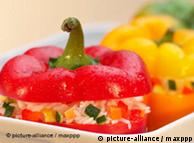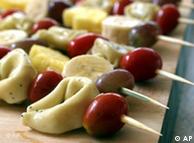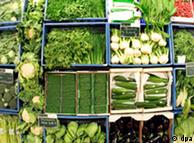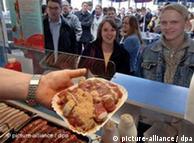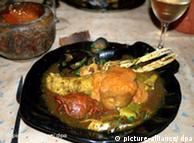In Paris, a Critic Criticized
Published: January 13, 2009
PARIS
Skip to next paragraph 
Valerio Mezzanotti for The New York Times
HE CUTS HIS WAY François Simon, a food critic in Paris, protects his identity.

Disney/Pixar
DOES HE BLOG? Anton Ego, the food critic in the animated film “Ratatouille,” was supposedly modeled on François Simon of Le Figaro.

Valerio Mezzanotti for The New York Times
IN THE KITCHEN Le Cochon à l’Oreille, the restaurant in Paris where Mr. Simon cooked for diners who had won a meal.
WHEN the sommelier in the overpriced Paris restaurant started to refill the glass without asking, François Simon stopped his hand in midair before a drop could fall.
“I like to control the temperature of my wine,” he announced. “In a restaurant, I am horrified by having to obey. I want to be indulged.”
Mr. Simon may be the most feared and most read figure in France’s culinary world, an ordinary looking man with a fountain pen as razor-sharp as a butcher’s slaughter knife.
As food critic for the right-of-center Le Figaro newspaper for more than two decades, he has skinned, sliced, grilled and roasted his subjects, indifferent to the impact of his words on them, but can be thin-skinned when they hit back.
He once described a meal at the restaurant Guy Savoy, a Michelin favorite, as “a three-star crucifixion,” faulting Mr. Savoy for serving his signature artichoke and truffle soup out of season. Marc Veyrat, who enjoys an unheard-of perfect 20-20 score in the Gault-Millau guide, is for him a “clown” and “a fake peasant” with megalomaniacal tendencies.
He has extended his reach with books, a weekly cable television show in which he hides his face and a blog that includes his secret video recordings with a hand-held camera of some of the great and not-so-great tables of France.
Not content simply to pass judgment on others, Mr. Simon claims to be an accomplished cook himself. His blog, in both French and English, boasts that he can cook a chicken 200 ways.
Last month, though, he took a step that few of his colleagues would have dared. He closeted himself in the kitchen of the tiny, mural-tiled bistro Le Cochon à l’Oreille and cooked five nights in a row, each night for 20 or so diners who had won the free meals in a first-come-first-served Internet sign-up.
Mr. Simon’s debut as a chef occurred during the annual “Le Fooding” week, sponsored by a French gastronomic movement that he strongly supports and that promotes an egalitarian, irreverent approach to dining. He announced his kitchen stint on his blog and in his column, and by the time he was ready to cook, much of the French media world had taken note.
The meal was barely adequate, according to five diners one night. The pumpkin soup, seasoned heavily with ginger, vanilla and black sesame oil, was grainy, undercooked and so dense it stood up in stiff peaks.
“I’m disappointed,” said Julie Demarest, an administrator in a water purification company. “It’s thick — like oatmeal. I don’t like it.”
The spiced chicken with pine nuts and golden raisins filled the dinner plate, but was accompanied only by an underdressed green salad. The zabaglione with sake was frothy and thin rather than creamy; the centers of the macaroons were chewy rather than soft. When the maître d’hôtel offered seconds on the dessert, there were few takers.
“Those macaroons — they’re so hard they could choke a Christian,” said Marc Beekenkamp, a Web designer, using an expression that means the dish is hard to digest.
But his colleague and friend, Matthieu Zerafa, came to Mr. Simon’s defense. “Every day he sits in judgment, and now it’s his turn to be judged,” he said. “You have to compliment him on one thing — he has a lot of nerve.”
That point, at least, has never been in dispute. Mr. Simon prides himself on being an outsider and a provocateur. His columns describe not only a restaurant’s food, but also its service, décor and clientele, even down to the movement of the breasts of women around him.
Mr. Simon has created such a buzz around himself that some French reporters called him the model for Anton Ego, the dour, unforgiving food critic in the 2007 animated film “Ratatouille.”
Brad Bird, the film’s director, said through a spokesman that the character was a pastiche derived from many sources. No matter: Mr. Simon was quick to assume Anton Ego’s persona.
“Since ‘Ratatouille,’ it hasn’t stopped: I’ve become the darling of my nephews,” he wrote in his blog, “Simon Says.” He said that he loved it when his friends started calling him Anton Ego, writing: “This low-life Anton is a good guy. He sacrifices his reputation to celebrate the cuisine of a rat.”
Mr. Simon has little use for the Michelin and Gault-Millau grading systems that have created a rigid gastronomic hierarchy and transformed chefs into superstars.
He has charged that politics often drives Michelin to sprinkle stars on less-than-worthy chefs. He relentlessly attacks certain multistarred French chefs and regularly proclaims that France has lost its “culinary supremacy.”
Even before the British celebrity chef Gordon Ramsay opened his restaurant in Versailles last spring, Mr. Simon panned it. “Dishes like his starter of cream of Jerusalem artichokes with lardons of bacon and cabbage can be found in 70 Parisian restaurants which are just as good,” he told The Daily Telegraph. “What’s more, he is British, and Parisians don’t like going to Versailles — it’s much too far.”
Mr. Simon accuses Alain Ducasse (with whom he once wrote a book on Provence) of empire-building commercialism, stratospheric prices, “photocopied cuisine” and worst of all, absenteeism from his many restaurant kitchens. He said Le Jules Verne, the Ducasse restaurant at the top of the Eiffel Tower, serves food “worthy of an airplane, first class — no, rather, business class.”
He has nothing good and everything bad to say about many of Paris’s gastronomic icons, including La Tour d’Argent, Hélène Darroze, Le Procope, Allard, Maxim’s and Brasserie Balzar.
“My real problem is that chefs are used to extremely excessive literary praise,” Mr. Simon said in an interview over a lunch in a restaurant where the appetizers averaged more than $40 apiece. “They become insufferable, divas. They can’t take the least criticism. But when you talk of them like they’re Beethovens or Mozarts, you’re lying.”
As for sommeliers, he wrote, “Perhaps we should drown them, to allow us to drink as we please.”
For Nicolas de Rabaudy, a food writer who has reviewed Mr. Simon’s books, Mr. Simon has become both mean-spirited and self-absorbed.
“His ego has surpassed him, the poor François,” Mr. de Rabaudy said. “I mean, come on, François Simon is the only person who doesn’t like Guy Savoy’s artichoke and truffle soup. It’s one of the great dishes of modern French cuisine.”
Asked about Mr. Simon and his sharp pen, Mr. Savoy said: “Frankly, what he writes or says doesn’t interest me one bit. Life’s too short.”
The most savage criticism of Mr. Simon came after the suicide of the Michelin three-star chef Bernard Loiseau in 2003.
Early that year, before Michelin announced its annual star ratings, Mr. Simon had written in two columns that Mr. Loiseau was to have lost one of his three stars, but had managed to hold onto it. Days after one column appeared, Mr. Loiseau killed himself.
The chef Jacques Pourcel, head of the Chambre Syndicale de la Haute Cuisine Française at the time, openly accused Mr. Simon of contributing to Mr. Loiseau’s death.
Mr. Simon defended himself, saying in the interview that it was convenient for the chefs of France and Michelin to identify “a naughty boy who did villainous things.” He added, “This misunderstanding will last forever.”
Mr. Loiseau suffered from serious depression. Asked whether Mr. Simon’s reviews played a role in her husband’s death, his widow, Dominique, who runs the restaurant, said, “It’s giving him too much importance.”
Mr. Simon also showers criticism on other French food critics, faulting them for identifying themselves in restaurants, cozying up to chefs and taking free meals and gifts. “It is much easier to turn into a courtesan, to be inside rather than outside the house of the chefs,” he said.
But other critics call his aloof approach sterile. “I want to get to know the chef, to understand what he feels, his frame of reference, his roots,” said Jean-Claude Ribaut, the longtime food critic at Le Monde. (Mr. Ribaut pays for his restaurant meals.) “I want to know if he grew up on a farm, if his father grew vegetables. If you go anonymously, you can’t ever have this kind of dialogue.”
Even though Mr. Simon books reservations under an alias and pays for his meals with alias credit cards, his face is known to many chefs, and his sideburns, flyaway hair and sartorial daring — bold tweeds, loud ties, velvet vests — sometimes give him away.
Mr. Simon portrays himself as close to his readers, soliciting their comments by printing his direct phone number at the bottom of his columns. He shamelessly boosts his favorites, including Yannick Alléno of Le Meurice, Pascal Barbot of L’Astrance and his favorite bistro, Paul Bert, in the 11th Arrondissement. Ravioli with tomato sauce prepared by the Italian chef Fulvio Pierangelini at Gambero Rosso in San Vincenzo “almost makes me cry with emotion,” he said. He called a truffle à la croque au sel with a glass of Montée de Tonnerre chablis at Lucien Vanel in Toulouse, now defunct, “better than cocaine.”
Even his admirers want him to tone down. “He’s got a strong character, his articles are fun and he doesn’t pontificate,” said Christian Millau, co-author of the Gault-Millau guide, who gave Mr. Simon his first job as a critic 30 years ago. But, he added, “Sometimes I tell him not to overdo it.”
Basil Katz contributed reporting.
法知名食評家賽蒙下廚 被批難吃
- 2009-01-15
- 中國時報
- 【鍾玉玨/紐約時報十四日報導】
法國當今最知名的美食評論家佛蘭斯瓦.賽蒙(Francois Simon)為《費加洛報》撰寫美食評論,此君長相沒人見過,一般只知道他大約四十歲,但筆鋒極犀利,曾有一位大廚被他點名應遭《米其林評鑑》降級而自殺,可見此人在法國餐飲界的重要性。不過火力十足的賽蒙,最近也成了他人攻擊的箭靶。
賽蒙的工作就是帶著隱形攝影機,到處品嘗美食。有次在巴黎一家高檔餐廳,一位侍酒生問也沒問,對著杯口準備倒酒時,被賽蒙用手制止,表示他想要自己掌控酒的溫度。他說:「顧客在餐廳只能任人擺佈,實在匪夷所思。我要享受,當大爺。」
賽蒙的美食評論廣受拜讀,但不假辭色的程度也令人害怕。他的筆鋒犀利,下手毫不留情,根本不管可能造成的殺傷力,二○○三年甚至發生米其林三星主廚Bernard Loiseau看了他的報導而自殺的憾事。
米其林評鑑的常勝軍巴黎Guy Savoy餐廳在賽蒙筆下似乎不過爾爾。他批評餐廳的菜色「讓三星背上了十字架」,因為主廚Guy Savoy的招牌菜-朝鮮薊與松露湯用的竟是非當季食材。而獲《高特米堯評鑑》(Gault Millau)廿分最高評鑑的主廚Marc Veyrat在賽蒙眼中,不過是只會耍技的「小丑」與「冒牌農夫」。
除了幫《費加洛報》撰寫專欄,賽蒙也出書、主持電視節目、開闢部落格,但或者因為去餐館怕被認出,他從來不以真面目示人。
許多美食專家只會說得一口好菜,卻完全不近廚房,但賽蒙宣稱,自己是道地的烹飪高手,並在部落格上誇口光是雞肉,他就發明了兩百種煮法。
上個月,賽蒙做了一樣同業不敢輕言嘗試的大膽之舉。他在巴黎餐館「獨耳小豬」(Le Cochon a l'Oreille),連續五晚親自上陣,端出拿手菜免費招待上網報名的前廿多位幸運兒(一晚約招待五人)。
不過這位「大師」的手藝並不叫座。一位有幸與會的民眾透露,最多只能稱得上差強人意。南瓜湯太稠又未煮熟,猶如燕麥糊,讓人失望。主菜辣 味雞稍嫌寒酸;甜點沙巴雍不夠綿密;馬卡龍杏仁小圓餅外皮太硬不夠酥脆。儘管大師勇氣可嘉,但這次卻踢到鐵板,嘗到挨轟的滋味。
被問及為何老愛對名廚開砲,賽蒙坦言:「名廚習慣被吹捧,因此變得毫無抗壓性,一點批評都受不了。」尤其對頂著米其林與高特米堯頭銜的名廚更是不假辭色。
由於賽蒙已是法國餐飲界炙手可熱的「達人」,一些記者認為他就是二○○七年動畫《料理鼠王》那位最有權力的美食評論家柯博先生 (Anton Ego)的翻版,為人剛愎又尖刻。一如法國美食作家Nicolas de Rabaudy對賽蒙的評語:自以為是、尖酸刻薄。
不過賽蒙對於自己和柯博先生劃上等號,似乎不以為忤。他說:「自從料理鼠王上映後,我成了侄子們的偶像。這位柯博先生為人善良,犧牲自己的名聲與地位,竟然美言一隻老鼠所做的菜。」
